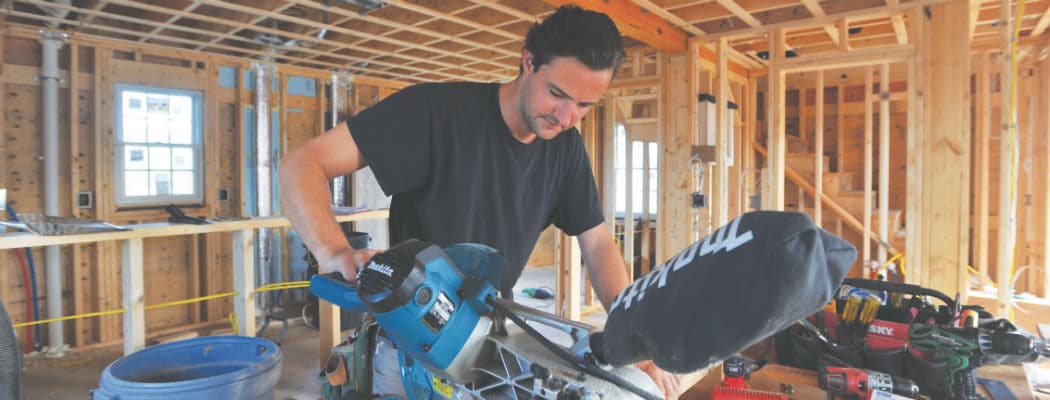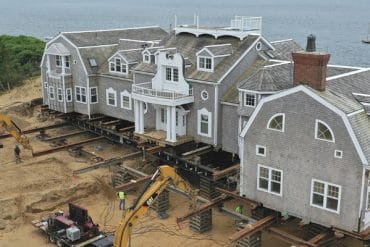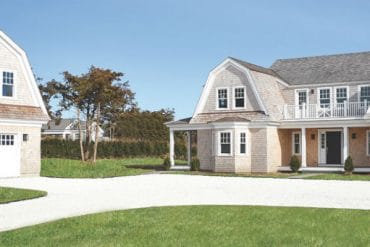Habitat Nantucket is helping local families move into their own homes.
In January of 2016, Liam Sherry and Sophia Orr won the lottery — the housing lottery that is. Like many year-rounders, the young couple felt the crushing weight of the island’s housing crisis bearing down on them. It’s an all-too-familiar story: Young couple works multiple jobs to make ends meet. They sign a lease on a poorly maintained rental unit that they can barely afford, yet consider themselves lucky to have found. But then after a couple of years, the septic system fails and they get evicted right before Christmas. With no viable alternatives, Liam and Sophia were forced to move into the spare room at Liam’s mother’s house, an option they also considered themselves fortunate to have. They searched with desperation for another rental but weren’t able to find one.
 “We didn’t know what to do,” says Sophia. “It seemed like we would have no choice but to leave Nantucket. And then we got the phone call. It was the most amazing thing that could have happened.”
“We didn’t know what to do,” says Sophia. “It seemed like we would have no choice but to leave Nantucket. And then we got the phone call. It was the most amazing thing that could have happened.”
In the spring of 2015, a chance meeting with a family friend who was dining at Center Street Bistro, where Sophia waits tables as a side job, led to her and Liam applying for the Sachem’s Path and Habitat for Humanity affordable housing lotteries. It was almost on a lark, as neither of them really thought they’d be seriously considered.
Sophia and Liam’s new home is the first Habitat house to be built in Sachem’s Path, one of the island’s most recent affordable housing projects created by the Nantucket Housing Authority (NHA). “With Sachem’s Path, we wanted to mix things up a bit,” says NHA executive director Renee Ceely, underscoring that over the years her organization had been doing a lot for rentals but wanted to do something more for home ownership. It took six years to get the legislation passed to be able to do a mixed income home-ownership development. As a result, Sachem’s Path now accommodates a broad spectrum of income groups. When complete, it will feature forty owner-occupied houses, including three that are being built by Habitat Nantucket.
Founded in 2001, Habitat Nantucket is a local affiliate of the international Habitat for Humanity organization, which brings professional trades- people and community volunteers together to build homes for people in need. The organization serves residents who make up to 80 percent of the area’s local area median income, and it relies on support from the community in the form of donations of funds, materials, services and land.
“It all starts with the land,” says Richard Hussey, Habitat Nantucket’s vice president. “Land is like gold out here.” Not surprisingly, acquiring land is also the organization’s biggest challenge. Prior to Sachem’s Path, they were negotiating with the town for land. “Now, we’ve got three to four years of work planned out ahead of us, which is a very good position for the organization to be in,” says Joe Grause, the former treasurer and soon-to-be president of Habitat Nantucket.
 After acquiring the land, the next step is to fundraise to cover construction costs. Over the last fifteen years, 90 percent of these funds have come from the Community Preservation Committee (CPC). “We are not the biggest entity that they support,” says Grause. “But the CPC has been very good to us.” The town and local tradespeople have also been tremendously supportive, he notes.
After acquiring the land, the next step is to fundraise to cover construction costs. Over the last fifteen years, 90 percent of these funds have come from the Community Preservation Committee (CPC). “We are not the biggest entity that they support,” says Grause. “But the CPC has been very good to us.” The town and local tradespeople have also been tremendously supportive, he notes.
Ultimately, the goal of Habitat Nantucket is to help very low-income families own their homes. To be clear, Habitat lottery winners like Liam and Sophia don’t actually win a free home. They win the opportunity to buy a home with a 0% mortgage. Additionally, new owners must spend 350 hours of “sweat equity” helping the other volunteers build their home. “That’s sort of their down payment in a commitment sense,” says Grause. Additionally, if the owners later decide to sell the home, they can only sell it back to Nantucket Habitat; they cannot put the home on the open market. It takes Habitat Nantucket approximately twelve to eighteen months to complete a single house. And it literally takes a village of volunteers to get the job done. (No experience necessary, by the way. Construction supervisor, Craig Spery, will teach you all you need to know.) The organization’s first house was started in 2003, and it’s built seven more since.
When it comes to easing the affordable housing crisis on Nantucket, even Grause and Hussey admit that what they do is just a “drop in the bucket” compared to the larger-scale solutions that organizations like the NHA and Housing Nantucket are working on. “The town is under pressure to build affordable homes,” says Grause. “There are about 2.5 percent of them in the housing stock, and they’ve got to get to 10 percent.”
That means 368 ad ditional affordable homes need to be created to meet the requirements of the state’s Subsidized Housing Inventory, according to Anne Kuszpa, the executive director of Housing Nantucket. “What’s happening on Nantucket with affordable housing is uniquely challenging,” says Kuszpa. There are the natural boundaries of the island. More than 60 percent of the land is restricted for conservation. Plus, with a 14 percent population increase since 2000, Nantucket is one of fastest growing communities in the nation. “In the state, it’s second only to Martha’s Vineyard,” she says. Yet year-round housing units are decreasing.
 “What appeals to me, and what appeals to our board,” Grause explains, “is that we’re providing a different model of affordable homes for Nantucketers from what Housing Nantucket and the NHA offer, which is predominantly rentals.”
“What appeals to me, and what appeals to our board,” Grause explains, “is that we’re providing a different model of affordable homes for Nantucketers from what Housing Nantucket and the NHA offer, which is predominantly rentals.”
Former selectman Tobias Glidden explains that he sees affordable housing on Nantucket like a tool bag. “You need to have as many different tools as possible to deal with the problem,” he says. “Habitat Nantucket is one of the tools. They provide a niche product… and really get people engaged in community involvement.”
As for Liam and Sophia, they say that owning the Habitat home will be “an immeasurable improvement” for them. And Liam, in particular, has been enjoying the sweat equity factor: “It’s very satisfying to be able to work on my own house and to know that things are being built as I would like.”






